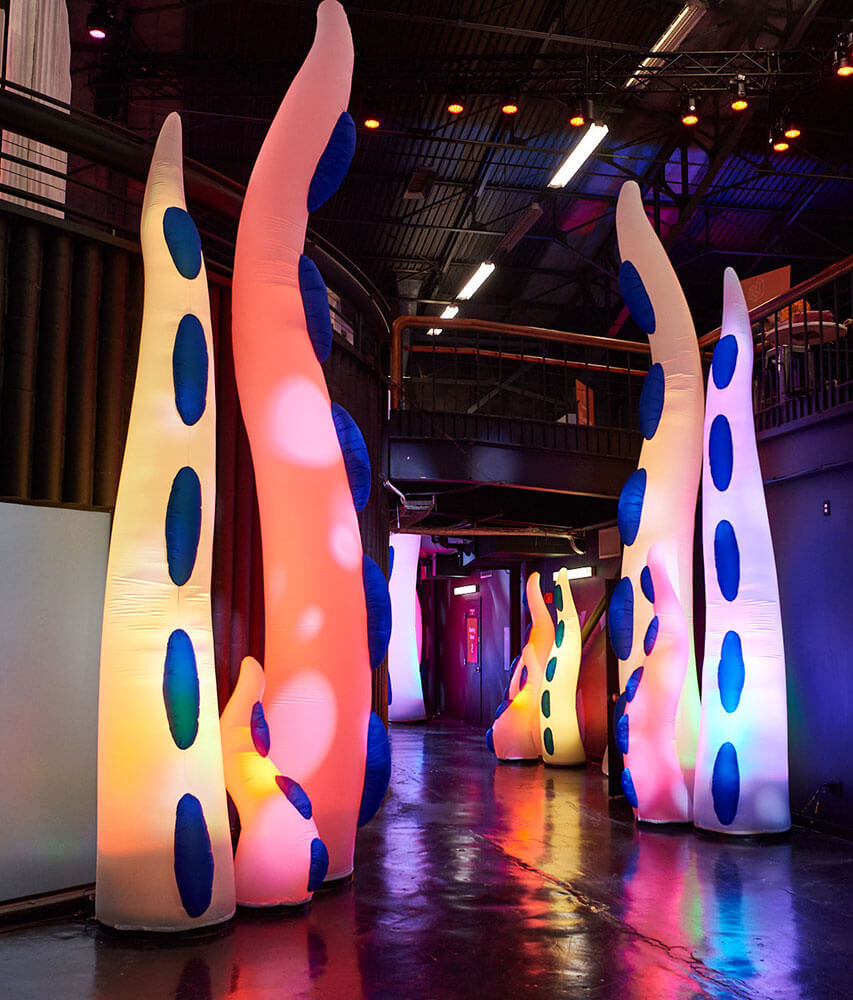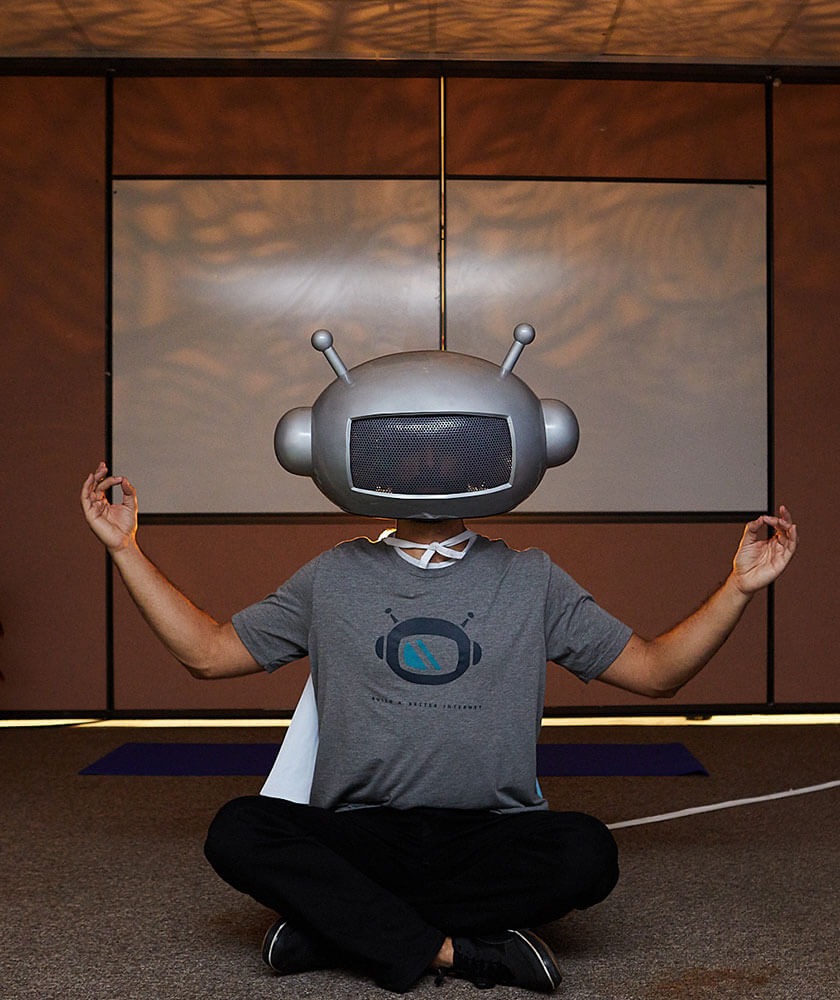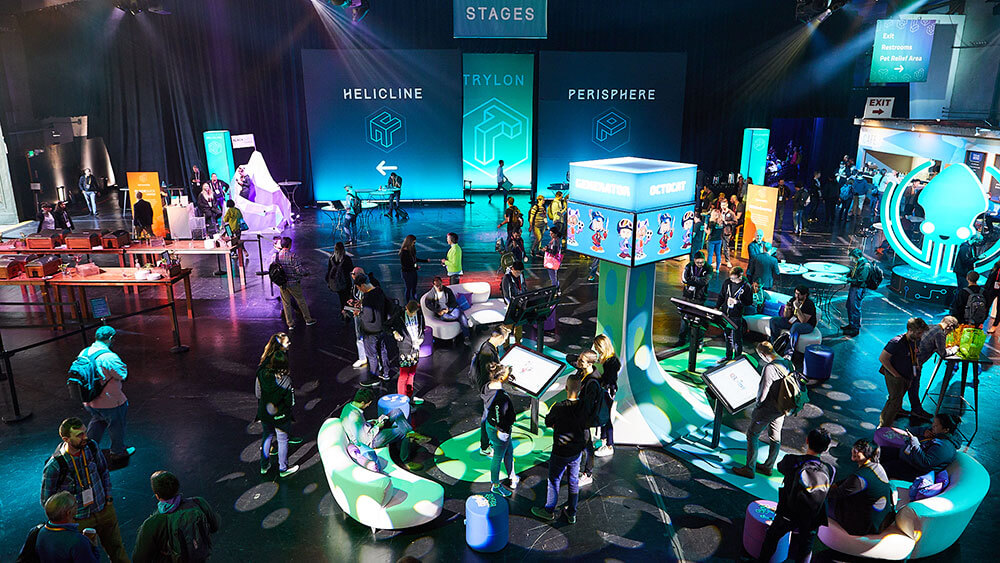
Attendees at GitHub Universe soak up the tech and the venue — the Palace of Fine Arts, the only structure standing from San Francisco’s 1915 Exposition. (Photos courtesy GitHub)
Web hosting company GitHub launched its first conference for software developers in 2015 at San Francisco’s Pier 70. It was a good fit — the venue’s raw, industrial atmosphere underscored the company’s funky DIY vibe — and the company brought GitHub Universe back to Pier 70 for its 2016 and 2017 editions. But in 2018, the venue was in the throes of a multi-use project redevelopment and unavailable over GitHub Universe’s dates, Oct. 16–17.
Hosting the event in a new venue was among a number of new moves that GitHub needed to make for its fourth conference. The tech company had a new goal of increasing conference revenue without physically growing the event much beyond its 1,700 attendees, for fear of sacrificing its intimate atmosphere. Then, there was the small matter that GitHub had just been bought by Microsoft in June for a cool $7.5 billion — and wanted all the optics to convey that it was still the same edgy, personal, and inclusive community it had always been.
When the company’s event producers tried to figure out how to manage it all —increasing profits but not size, while conceptualizing a new venue, and keeping it real — they decided they needed help. They reached out for RFPs from event agencies with a reputation for innovative work.
“One of my colleagues who manages sponsorship had visited [Intuit’s] QuickBooks Connect conference in San Jose and was very impressed by the quality of production put on by its coordinator, Agency EA,” said Kelsey Schimmelman, GitHub’s senior event producer. “So when we put Universe 2018 up for RFP, we submitted it to them.” In addition to Intuit, Agency EA has worked with Google, Oprah Winfrey, and the Obama Foundation. “Their pitch impressed us so much,” Schimmelman said, “that we switched from our incumbent vendor.”
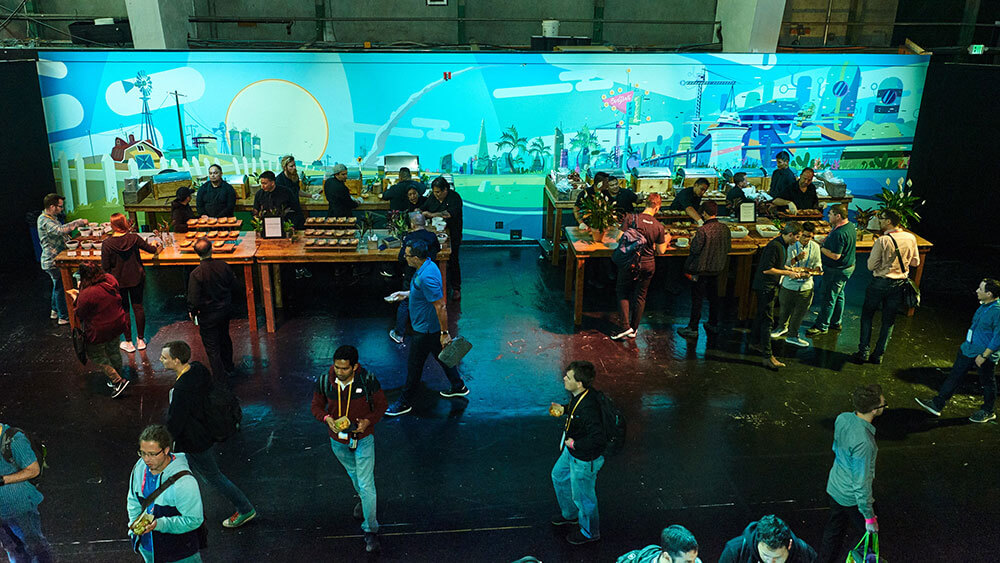
The landmark Palace of Fine Arts provides GitHub with a blank canvas for activation and engagement.
Festival Space
GitHub’s goal is to outdo itself, year after year, while continuing to prioritize the needs of every attendee. The challenge for Agency EA was not just changing locations, but finding a location that could support a festival ambience scaled down for intimacy and creating a space that would enable them to woo more sponsors more substantively and lucratively.
Given GitHub’s preference to stay in San Francisco, Agency EA eyed a historic city landmark with a World Fair pedigree: The Palace of Fine Arts. The only structure still standing from San Francisco’s 1915 Exposition, the Palace is a tall drink of water, from its dramatic Greek-style colonnades to its soaring central rotunda. (Unsurprisingly, its exterior is also an extraordinarily popular wedding-photo backdrop, a reality any event there must cheerfully contend with.) The interior is a high-ceiling space like an airplane hangar, a tabula rasa for creativity.
“It was beautiful, and so much fun to create an almost shocking juxtaposition of this classical, stunning architectural style on the outside,” Schimmelman said, and creating a playground for attendees with “a super high-tech, colorful, well-lit interior.”
A statement location like this with flexible space gave GitHub the freedom to put up walls to reconfigure the square footage. But with that flexibility and creativity comes a certain amount of unpredictability.
“The venue was a great fit for the client, kind of quirky and unique like their brand is,” said Kristin Barbour, account director at Agency EA. “They typically like non-trade venues, and are conscious of not turning into your typical conference. They never aspire to be a Moscone event. But it’s a raw space so we knew we’d have to get creative with space blocking. The floor space is a challenge, and the configuration can change by the week, depending on what was done by a previous client.” Indeed, when Barbour and her colleagues visited the space two weeks before the conference, they found that there was an entirely new room in the space where they’d planned to place tech tables.
Agency EA addressed the nontraditional space and need for breakouts by building a 360-degree open stage for the general session, which could be divided into three triangular spaces curtained off for smaller stage events. The lighting was likewise divisible: A large, circular, overhead LED deck had a custom triangular divider nesting inside, and it could be lowered in pieces for the needs of the subdivided stage in-the-round.
“It’s a totally different experience for general sessions when you use a 360-degree stage. You get up close and personal with the speakers,” Barbour said. “It’s all visible, all accessible, with less attention to what the walls are than the freedom of what you want to do in the total space.”
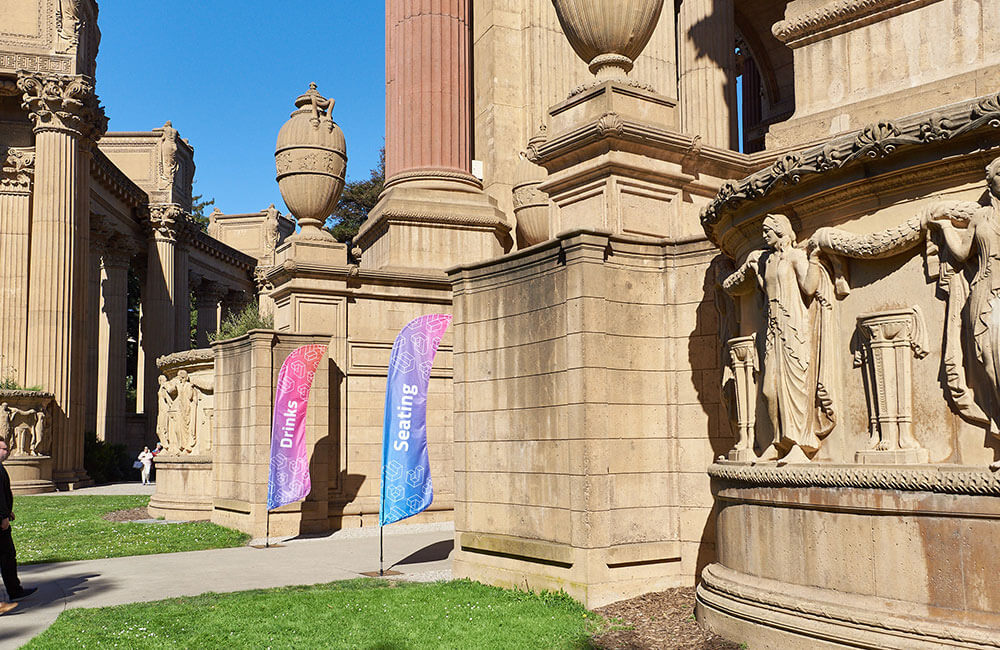
The Palace of Fine Arts’ classical exterior stands in striking juxtaposition to GitHub Universe’s creative use of indoor spaces.
All-Inclusive
When she says accessible, she doesn’t just mean it figuratively. To maximize the acoustics and minimize sound bleeding from one subdivided stage to another, an under-seat audio system was installed, with speakers wired under the chairs to keep the sound experience hyper local. The sessions were also fully closed-captioned, useful not only for the hearing-impaired (there was an ASL interpreter on hand) but for the large number of livestream viewers — 250,000 remote viewers over the two days of the show — who might be watching in an environment with the volume down.
“GitHub knows they have a broad customer base of code developers all over the world, and they want to make sure everyone could have the same experience at the event,” Barbour said.
Accommodating the needs of the hearing-impaired was one of a number of GitHub’s initiatives to take care all of their attendees and to ensure that they all felt welcome. “It was important to have full inclusivity features,” Barbour said. GitHub “set the foundation, and our team ran with it. They traditionally have a meditation room, just a quiet place to go, but we made sure it also had prayer rugs and ambience lighting. Same thing for the parents’ room, a little place where we brought in children’s books and nursing stations so multiple parents could be in there at the same time.”
The event was fully ADA accessible, and as comfortable for mothers with babies as for attendees with service dogs. Restrooms were gender neutral. Gift-shop swag included GitHub logo onesies for the littlest future coders, as well as trans and pride T-shirts, and preferred pronoun stickers for name badges. Service animals were welcome on the conference floor, and accommodated with a pet relief area and treats.
A scholarship program enabled people to attend the conference — students and people from marginalized communities — who otherwise might not have the means to register. “This accessibility is something we’ve always done. It’s a core part of our event values,” Schimmelman said. “These are some of the people who do the most interesting work on GitHub, and it’s important that they be there.”
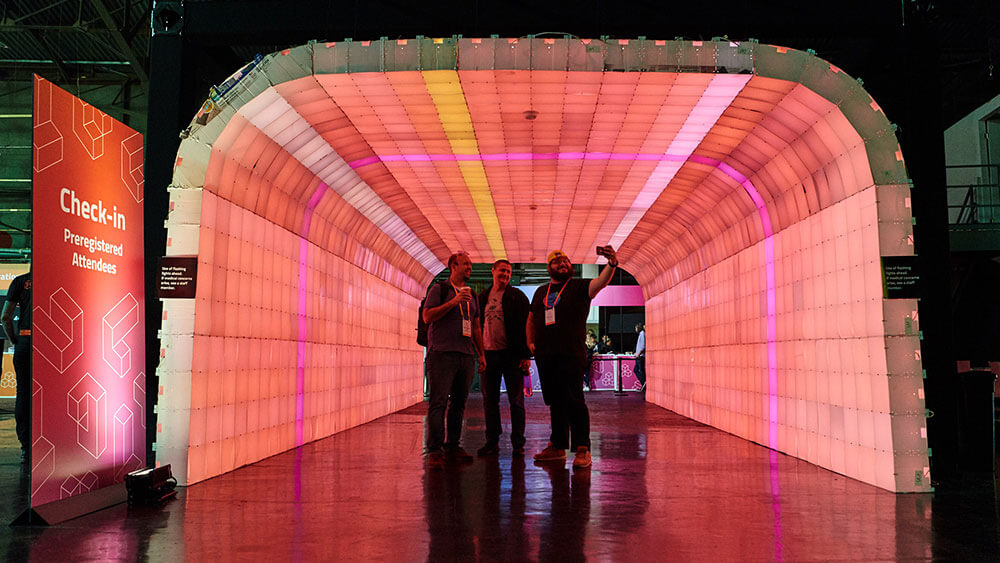
A tunnel entryway that changed colors is another example of how organizers of GitHub Universe 2018 used experiential design whenever they could.
Sponsor Customization
The individualized attention extended as thoroughly to the sponsors. At Universe 2018, they were assured the sponsorship experience wouldn’t be about cookie-cutter rental structures, logos slapped on walls, and typical giveaway tchotchkes. Everything was customized for each sponsor.
“There were 30 sponsors across several different tiers, requiring a capacity of customization and level of detail we had never really done before,” said Angelina Spaniolo, senior creative strategist for Agency EA. Logos and brand representations would be more abstract, so rather than a chaotic branding experience, attendees walked through a gallery environment — with curated décor, texture, and lighting. “Each sponsor had their own art installation and we worked deeply with them, bringing to life a buildout to showcase their brand in a special light,” Spaniolo said.
GitHub is an open-source community, after all, and that individuality is a big part of who they’re bringing to the platform. Having an attention-catching way of presenting who these sponsors are — and what they could do for developers — was very important to Universe 2018. “It was all custom-built. With sponsors, you are on tight budgets, and trying to figure out creative budget-conscious installations,” Spaniolo said. “We had graphic designers and fabrication partners helping us see all these through from a build perspective.”
The installations and price points varied by footprint size, function, and add-on services. An 8-by-8-foot footprint focused on something visually compelling, a photo-op stop. A 10-by-10-foot space was designed to be an interactive hangout, and a 20-by-30-foot area was a sort of developer lounge, meant for relaxation and interaction. Sponsorship packages included options for interactive components and demo stations, and the customization was virtually limitless. One sponsor with ship references in its branding story was represented with a live aquarium, filled with fish genetically modified to glow under black light. Another had a 10-foot-high, glow-in-the-dark Kraken sea monster on a giant pedestal, while elsewhere in the room, another sponsor had a large remote-controlled excavator in a sandbox.
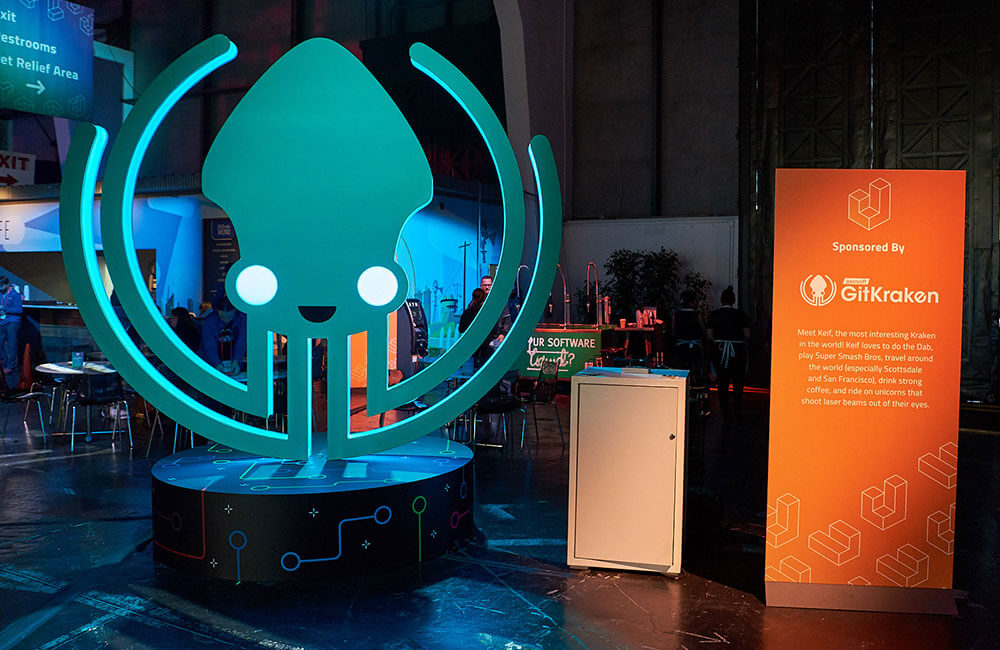
One sponsor of GitHub Universe was represented with a 10-foot-high, glow-in-the-dark Kraken sea monster on a giant pedestal.
Room to Play
But in the end it wasn’t only about the wow factor: Attendees had to know beyond a shadow of a doubt that they were at a GitHub event. And that’s where the role of whimsy comes in.
“I think our community is really great in terms of the way they embrace play. A lot of developers have a child-like wonder and openness to approach things with a sense of new eyes,” Shimmelman said. “When you’re in that state of mind, you’re in this great head space to make new connections and friends, and that’s a great way for people to network. I like anything that encourages attendees to play. I knew immediately that the adult playroom would be a hit.”
Yes, adult playroom. One sponsor decided to bring a children’s play space alive for adults, including a 10-foot-high teddy bear and life-size rocking horse. Coloring vinyls were available on highboys for spontaneous arts & crafts. And a giant toy box glowed yellow from within, emanating angelic noises and filled with branded giveaway items that would appeal to children.
GitHub provided some of its own interactive whimsy with an Octocat (its mascot) Generator Lounge, where attendees could make their own custom avatars at kiosks, adding hair and clothing to the cult-star Octocat. “People walked away feeling they had their own little piece of the GitHub brand,” Schimmelman said. “We’re lucky our community is willing to do so much evangelizing. We really have fans rather than users, and we try to respect that.”
The proof of the event’s success was evident in the way it hit its markers: positive feedback from attendees and sponsors, and a solid revenue increase. “We had explicit revenue goals, and tripled the sponsorship — both in terms of the number of sponsors and the amount of revenue,” Schimmelman said. “I think marketing people at the conference recognize the value of an art-installation sponsorship in terms of the social-media attention it can generate.”
Many sponsors are accountable to executives back home, and expected to return with an Excel spreadsheet of all the cards they collected. But GitHub stresses a quality-over-quantity mentality, reflected in a comment from sponsor GitKraken on GitHub’s website: “We know we can count on having real conversations with people at GitHub events, and that attendees aren’t just visiting booths to get free stuff. GitHub strives to build an interactive environment for both sponsors and attendees, which creates real value.”
Amid the shiny objects there was real substance. The conference layout in the Palace included a gallery space to showcase the life and work of people doing interesting things using GitHub. There was a Detroit water project, in which a woman created a community platform to help donate to the water bills of people struggling to get clean water. And there was an organization that helps military vets learn to code so they can launch their careers post-deployment.
“GitHub is [about] business, but it’s people over technology,” Schimmelman said. “Technology is the landscape we all live in. But people are the subject of the stories we tell.”
Nichole Bernier is a writer and editor based in Massachusetts.
Programmed Fun at GitHub Universe
The focus on interactivity and conversation extended to leisure time during GitHub Universe. Social events were designed for maximum engagement and sensitivity to the audience of developers and coders, many of whom skew toward introversion. As such, GitHub’s Kelsey Schimmelman didn’t want to make the concluding after-party a sensory overload of dancing and loud music.
So 2018’s after-party tapped attendees’ innate curiosity for technology with a DJ who coded: As he spun the tunes, live code was manipulated and projected on a screen behind him, a technical visual representation of the music he played.
“People were standing around staring, and saying to each other, ‘Wow, that’s amazing,’” Schimmelman said. “It was another conversation piece for people to connect.”

